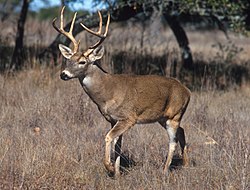| Odocoileini | |
|---|---|
 | |
| Odocoileus virginianus | |
| Scientific classification | |
| Kingdom: | Animalia |
| Phylum: | Chordata |
| Class: | Mammalia |
| Order: | Artiodactyla |
| Family: | Cervidae |
| Subfamily: | Capreolinae |
| Tribe: | Odocoileini |
| Genera | |
Odocoileini is a tribe of deer, containing seven extant genera and several extinct ones.
The common character of this tribe is vomerine septum that completely separates the choana. [2]